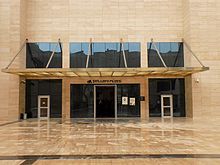Şanlıurfa Archaeological Museum
The Şanlıurfa Archaeological Museum ( Turkish Şanlıurfa Müzesi ) is located on Çamlık Caddesi in the center of the provincial capital Şanlıurfa in southeastern Turkey. The museum exhibits archaeological finds from the near and far surroundings of the city, including from Harran and Göbekli Tepe , as well as from rescue excavations as part of the Southeast Anatolia Project . In 2015 the museum moved to a new building on Nisan Fuar Caddesi.
history
The first plans for an archaeological collection in Şanlıurfa were made in 1948, initially the finds were stored in the Ataturk primary school, and from 1956 in the rooms of the Şehit Nüsret primary school. Since the available space was insufficient, construction of a museum building began in 1965. The exhibition with an area of 1500 m² was opened to visitors in 1969. An extension was added later.
exhibition
On two floors and mezzanines, the exhibition space consists of three halls for archeology and one for ethnography . There are also administration and conference rooms as well as a library. Storage, workshops and a photo laboratory are located in the basement.
The exhibits come from local sites, the best known are Harran, the early Neolithic Nevalı Çori and Göbekli Tepe. The well-known stele of Nabonid can be seen from Harran, a fragment with incised drawings and numerous small finds from Nevalı Çori, and steles and sculptures from Göbekli Tepe depicting various hybrid creatures. The collection also includes reliefs and large sculptures from Hittite sites in the area, including Gölpınar, Sefalı and Kabahaydar. In the outdoor area of the museum numerous capitals, steles and other architectural fragments from the Hittite to Roman to Islamic times are exhibited. The museum has a total of 74,000 finds.
The museum was involved in several rescue excavations related to the construction of the Ataturk Dam and the Birecik Barrage on the Euphrates , including Lidar Höyük, Hassek Höyük and the aforementioned Nevalı Çori. Since 1995, scientists at the museum have been digging up the more than 12,000-year-old cult site at Göbekli Tepe, 15 kilometers northeast of Şanlıurfa, in collaboration with Klaus Schmidt from the Istanbul Department of the German Archaeological Institute .
Stela of a Hittite nature god from Gölpınar
Stele of the weather god from Gölpınar
Coordinates: 37 ° 9 ′ 13 ″ N , 38 ° 46 ′ 55 ″ E
Web links
- Şanlıurfa Governorate - Provincial Directorate for Culture and Tourism ( Memento of March 23, 2013 in the Internet Archive )
- German Archaeological Institute Istanbul - Göbekli Tepe ( Memento from June 7, 2014 in the Internet Archive )
Individual evidence
- ↑ alaturka.info ( Memento of the original from May 2, 2012 in the Internet Archive ) Info: The archive link was inserted automatically and has not yet been checked. Please check the original and archive link according to the instructions and then remove this notice.
- ↑ The description of the rooms still refers to the old building in Çamlık Caddesi, no information is available on the new building.
- ↑ Şanlıurfa Museum ( Memento from October 28, 2012 in the Internet Archive )







